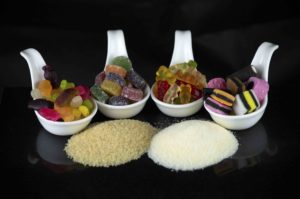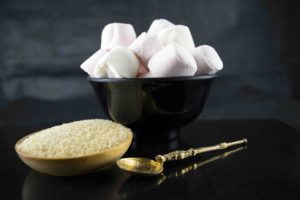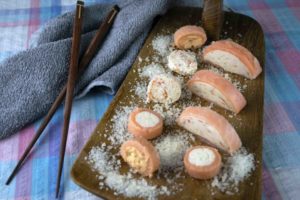Gelatine in food
Odourless, tasteless, colourless, transparent, yet able to take on any shape, colour, or flavour: gelatine in food is something of a chef’s dream, making a multitude of food types possible. Gelatine can be found in sweets, desserts, meat products, and also to clarify beer, wine and fruit juices.

Gelatine sweets are typically made from a base of sugar, glucose and water. To this base is added flavour, colour and texture modifiers. Gelatine is widely used in sweets because it foams, gels, or solidifies allowing a dissolving/melting sensation in the mouth.
Sweets such as gummy bears contain a relatively high percentage of gelatine. These sweets dissolve more slowly thus lengthening the enjoyment of the sweet while smoothing the flavour.
Gelatine is used in whipped sweets such as marshmallows where it serves to lower the surface tension of the syrup, stabilise the foam through increased

viscosity, sets the foam via gelation, and prevents sugar crystallisation. Gelatine is used in foamed confections at a 2-7% level, depending upon the desired texture.
Gummy foams use about 7% of a 175 Bloom gelatine. Marshmallow producers generally use 2.5% of a 250 Bloom Type A gelatine.
Another major use of gelatine in food is in desserts – Gelatine desserts both savoury and sweet, can be traced back to the middle ages in Europe.
Gelatine desserts can be prepared using either Type A or Type B gelatine with Blooms between 175 and 275. The higher the Bloom the less gelatine required for a proper set (i.e. 275 Bloom gelatine will require about 1.3% gelatine while a 175 Bloom gelatine will require 2.0% to obtain an equal set).
Variety in gelatine use
Gelatine in Meats – Gelatine is used to gel aspics, head cheese, souse, chicken rolls, glazed and canned hams, and jellied meat products of all kinds. The gelatine functions to absorb meat juices and to give form and structure to products that would otherwise fall apart.

Normal usage level ranges from 1 to 5% depending upon the type of meat, amount of broth, gelatine Bloom, and texture desired in the final product.
Clarification of Beverages and Juices – Gelatine has traditionally been used to clarify wine, beer and fruit juices. Fining of these beverages requires only 40 to 80 parts per million of a 100 to 200 Bloom gelatine. In practice a dilute (1- 3%) gelatine solution is introduced into the top of the tank and then allowed to settle before filtration.
Collagen from gelatine
Another use of gelatine is in it’s hydrolysed form commonly known as collagen which can be a food supplement. It’s also used to fortify dietary foods with protein as collagen contains over 92% protein.

Also available in capsule or tablet form, collagen is widely used in soups, shakes and fruit drinks. Proper use of collagen can improve well-being and diet.
Dietary concerns with collagen protein have been misunderstood for many years. While collagen has been described as an empty protein, or one having little nutritional value, it does in fact contain many essential amino acids, and is readily digestible.
